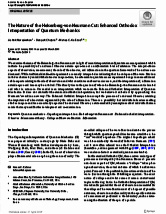Abstract: We examine the issue of the Heisenberg-von Neumann cut in light of recent interpretations of quantum eraser experiments which indicate the possibility of a universal Observer outside space-time at an information level of existence. The delayed-choice aspects of observation, measurement, the role of the observer, and information in the quantum framework of the universe are discussed. While traditional double-slit experiments are usually interpreted as indicating that the collapse of the wave function involves choices by an individual observer in space-time, the extension to quantum eraser experiments brings in some additional subtle aspects relating to the role of observation and what constitutes an observer. Access to, and the interpretation of, information outside space and time may be involved. This directly ties to the question of where the Heisenberg-von Neumann cut is located and what its nature is. Our model is an interpretation which we term the Enhanced Orthodox Interpretation of Quantum Mechanics. It does not contradict the standard orthodox interpretation, but we believe it extends it by approaching von Neumann’s work in a new way. The Enhanced Orthodox Interpretation accepts the presence of a universal Observer, retaining the importance of observation augmented by the role of information. There is a possibility that individual observers making choices in space and time are actually aspects of the universal Observer, a state masked by assumptions about individual human minds that may need further development and re-examination.
Research Article: Physics Must Evolve Beyond the Physical
This article recognizes Henry Stapp’s contribution to physics. Henry Stapp is a Spirit of Rustom Roy Award Recipient (2012)
Abstract: Contemporary physics finds itself pondering questions about mind and consciousness, an uncomfortable area for theorists. But historically, key figures at the founding of quantum theory assumed that reality was composed of two parts, mind and matter, which interacted with each other according to some new laws that they specified. This departure from the prior (classical-physicalist) assumption that mind was a mere side effect of brain activity was such a startling proposal that it basically split physics in two, with one camp insisting that mind will ultimately be explained via physical processes in the brain and the other camp embracing mind as innate in creation and the key to understanding reality in its completeness. Henry Stapp made important contributions toward a coherent explanation by advocating John von Neumann’s orthodox interpretation of quantum mechanics. von Neumann postulated that at its basis, quantum mechanics requires both a psychological and physical component. He was left, however, with a dualist view in which the psychological and physical aspects of QM remained unresolved. In this article, the relevant issues are laid out with the aim of finding a nondual explanation that allows mind and matter to exist as features of the same universal consciousness, in the hope that the critical insights of Planck, Heisenberg, Schrödinger, von Neumann, and Stapp will be recognized and valued, with the aim of an expanded physics that goes beyond physicalist dogma.


